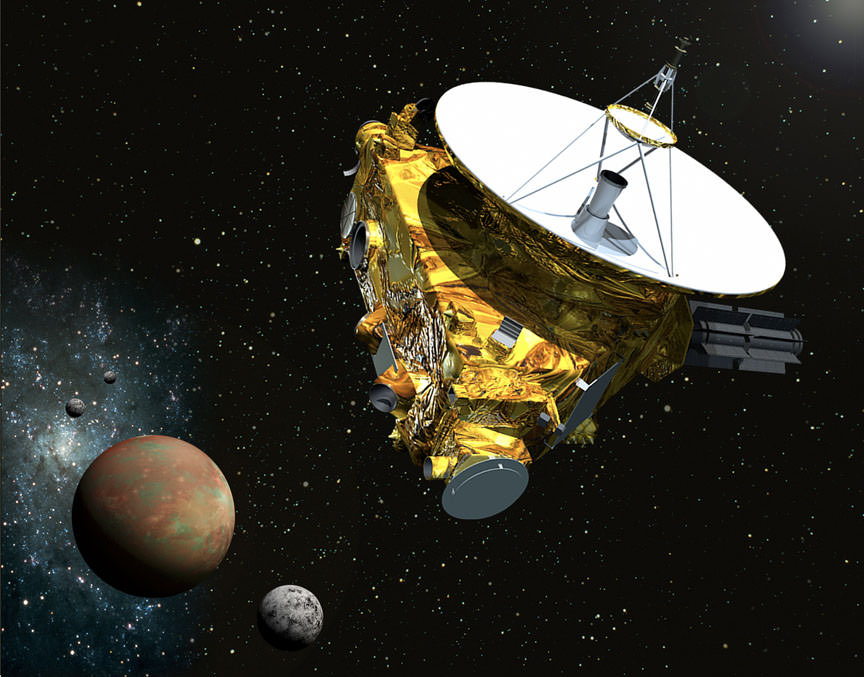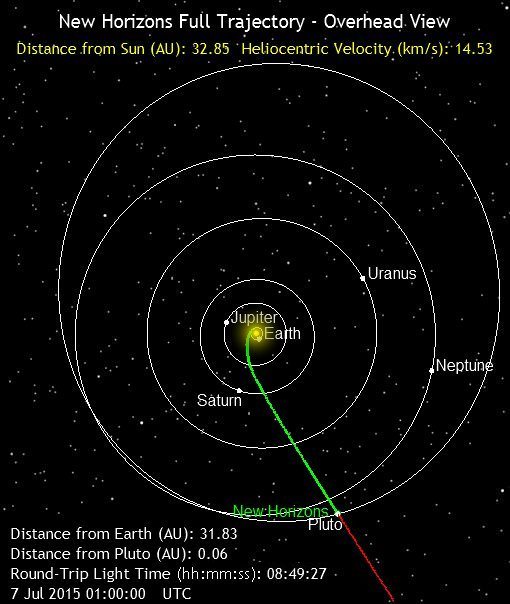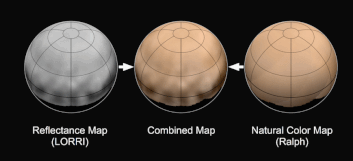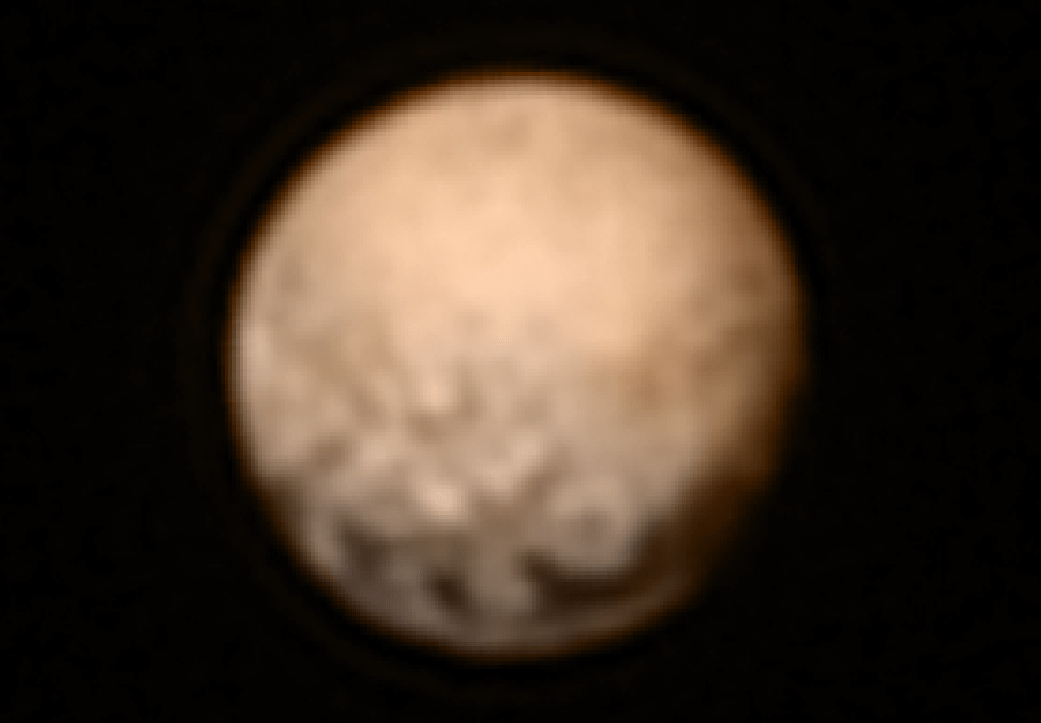Latest color image of Pluto taken on July 3, 2015 shows 4 mysterious dark spots.
Best yet image of Pluto was taken by the LORRI imager on NASA’s New Horizons spacecraft on July 3, 2015 at a distance of 7.8 million mi (12.5 million km), just prior to the July 4 anomaly that sent New Horizons into safe mode. Color data taken from the Ralph instrument gathered earlier in the mission. Credit: NASA/JHUAPL/SWRI
Story updated[/caption]
Despite some hair-raising and unplanned 4th of July fireworks of sorts in deep space which caused NASA’s Pluto bound New Horizons spacecraft to enter “safe mode” due to a computer glitch and temporarily halt all science operations over the weekend, the spacecraft is now fully back on track, “healthy” and working “flawlessly” and set to resume all planned research investigations on Tuesday, July 7, NASA and top mission managers announced at a media briefing held this afternoon, Monday, July 6.
It’s now just exactly one week before the once-in-a-lifetime opportunity for a fast flyby encounter of the ever intriguing binary planet, at the far flung reaches of the solar system. And the great news could not come soon enough given the proximity of the flyby.
“The spacecraft is in excellent health and back in operation. New Horizons is barreling towards the Pluto system,” stated Jim Green, director of Planetary Science, NASA Headquarters, Washington, at the start of today’s news media briefing.
The $700 million mission remains on track to conduct the complex close flyby science sequence in its entirety, as planned over the next week, including the July 14 flyby of Pluto, despite the scary safe mode episode.
“The New Horizons spacecraft and science payload are now operating flawlessly,” Alan Stern, New Horizons principal investigator, Southwest Research Institute, Boulder, Colorado, announced at the media briefing.
NASA unexpectedly lost contact with the New Horizons spacecraft on Saturday, July 4, at about 1:30 p.m. EDT after it suffered a memory related software anomaly and executed a protective operation known as “safe mode.” An anomaly investigation team was formed immediately.
“It’s really a historic time, but also fraught with many decisions and challenges on the way to the July 14 Pluto system encounter,” Green said.
The mission team quickly worked to reestablish contact with the piano shaped spacecraft about 90 minutes after the signal was lost.
“On Saturday we lost contact with the spacecraft. The New Horizons team immediately went into action. Within 90 minutes the signal was reacquired by the team, with the spacecraft in safe mode. They soon found the root cause and corrective actions were immediately taken to get the spacecraft back in business.”
The team worked tirelessly and diligently day and night over the holiday weekend to recover New Horizons back to full operation quickly and in time for the flyby encounter of Pluto on July 14, set for approximately 7:49 a.m. EDT (11:49 UTC) on July 14, said Glen Fountain, New Horizons project manager, Johns Hopkins University Applied Physics Laboratory, Laurel, Maryland.
There are no second chances.

The software glitch occurred a day after new operating software was uploaded to New Horizons last Friday.
The spacecraft was trying to do two things at once on Saturday, compressing science data and writing command sequences while using up too much flash memory, explained Fountain.
“The computer was trying to do these two things at the same time, and the two were more than the processor could handle,” Fountain said.
“So the processor said ‘I’m overloaded.’ Then the spacecraft did exactly what it was supposed to do. It then switched to the backup computer and went into safe mode. At that point, we lost the downlink from the primary computer. We realized quickly what happened and put a recovery plan in place and recovered.”

At this moment New Horizons is about 3 billion miles (4.9 billion km) from Earth and less than 6 million miles (9 million km) away from unmasking the secrets of tantalizing Pluto, Charon, its largest moon with which it forms a double planet system, and its four tiny and recently discovered moons. Charon is half the size of Pluto.
The round trip time for signals traveling at the speed of light is 8.5 hours. So it’s a very long time before commands from Earth can reach the spacecraft and for the team to determine their outcome. So the probe has to be able to operate on its own without direction from Earth during the intense and brief flyby period.
Pluto is the most distant and last unexplored planet in our Solar System, and therefore presents enormous complexities to those bold enough to dare the mightiest things.
“We expect a nominal flyby of Pluto from every indication now,” said Alan Stern, New Horizons principal investigator, Southwest Research Institute, Boulder, Colorado, announced at the media briefing.
“This object is unlike any other that we have observed,” Stern said. “Both Pluto and Charon are already surprising us.”
Less than 1 percent of the planned data was lost in the three days that the science instruments were shut off.
“It’s more important to focus on the later science during the flyby,” Stern elaborated.
“There is zero impact to the primary Group 1 highest-priority science objectives. And a minor impact to Group 2 and Group 3 objectives,” Stern elaborated.
“This is a speed bump in terms of the total return that we expect from this flyby.”
“I’m pleased that our mission team quickly identified the problem and assured the health of the spacecraft,” noted Green. “Now, with Pluto in our sights, we’re on the verge of returning to normal operations and going for the gold.”

The team said this type of software update will not be repeated and a similar type safe mode event should not recur.
Fountain said that during the encounter period, the probe can switch itself to exit safe mode event within about 7 minutes, depending on the situation, and minimize any science data losses.
New Horizons will swoop to within about 12,500 kilometers (nearly 7,800 miles) of Pluto’s surface.
It will zoom past Pluto at speeds of some 30,000 miles per hour (more than 48,000 kilometers per hour).
Today the team also released the best yet images of Pluto that were taken by the Long Range Reconnaissance Imager (LORRI). The trio of images were between July 1 and 3 of 2015, prior to the July 4 anomaly that sent New Horizons into safe mode.
The images show varying and enigmatic surface features on the different hemispheres of Pluto.
They also show the four mysterious dark spots on Pluto that have captured the imagination of the scientists and the world.
Their nature remains unknown at this time.
The probe was launched back in 2006 on a United Launch Alliance Atlas V rocket.
“We are on our way to Pluto!” Green exclaimed.
Stay tuned here for Ken’s continuing Earth and planetary science and human spaceflight news.



Trouble with this kind of journalese is the difficulty in relating cause/effect!
1. The software update must have been crucial to the mission’s success in returning science data to have been left so late in the mission.
2. Such a pity that energy considerations couldn’t have allowed some braking, so passage thro’ the system was slower, or even allowed orbit within the Pluto system? Guess the mission planners must have considered such options ……
It is doable with ion thrusters, but it could take several decades to get to Pluto. I think that next week is the only close look at Pluto we’ll have this century.
I found an animation posted summarizing post-Pluto encounters… https://www.youtube.com/watch?v=QWlGoSlIL08
It’s starting to look more and more like the moonface from “Le Voyage dans la Lune”. The four dark spots are obviously his eyes, nose and mouth. You can’t see the face clearly because we’re approaching from too far north. You would think NASA would have considered this before launching such an expensive spacecraft.
Indeed! 😉
Great that we’ve made it to Pluto. The dark spots on the Planet seem to me to be shadows; as there is correlating light spots above them. Even the Planet has the light coming from above. Can’t wait for the clear pictures.
The ring on the lower right looks volcanic. You could imagine other frozen volcanos in these blurry photos. Is Pluto just a big orbiting comet which has had past eruptions on its surface?
Probably just a photographic artifact but it looks like there’s an atmospheric haze around the planet.
WHO will be the first to walk on Pluto? That will happen some day you know ~ Might just be that special someone will be named Neil? Try to imagine where humans will be in 100 years? or 1,000 years? and DO something about it!
GO New Horizon’s!
I think by the time a person walks on Pluto it will be because they have gone by it so many times and say, heck are we ever going to drop in on this tiny ball, we passed it 100 times now, lol…
Let’s see if I have this right – the striped light/dark side’s picture is basically facing Charon which might be centered about 0° Long.
The northern hemisphere right now is in semi-perpetual “summer” (though Pluto is itself moving toward aphelion and thus winter) is light colored and below the equator in semi-perpetual darkness the land is itself also dark, occasionally with less dark regions such as the striped lighter areas mostly facing Charon.
In the northern hemisphere but near the equator on the Charon facing side there is some texture to the land – quasi circular regions that could be craters, volcanoes, or who knows what. To the East the land becomes less contrasted/textured broadly white (at this point.) Roughly on the opposite side of the planet the broadly white featureless area becomes less intensely bright generally, but opposite the stripped region facing Charon there is a broad bright white “square” region just north of the equator. South of the equator the deep dark region spreads out with a hint of white towards the south pole, but that could be atmospheric haze or a processing effect of the edge of Pluto.
Ah – and the side opposite the stripes, the side facing Charon, will be opposite close approach of New Horizons.
The broad sub-equatorial region is called “the whale” so far. And the striped region seems to ascend from south of the equator next to the bright equatorial region about opposite of Charon. That side’s highest resolution will be about 3 days before closest approach.
http://www.nasa.gov/feature/new-horizons-map-of-pluto-the-whale-and-the-donut
The article kinda implies this could happen and maybe so. But so close to flyby and with 8.5 hours of transmission time each way, I know there had to be some, oh snap what the heck happened, panic in the command center. Glad they got it going again, looking forward to more photos of Pluto.